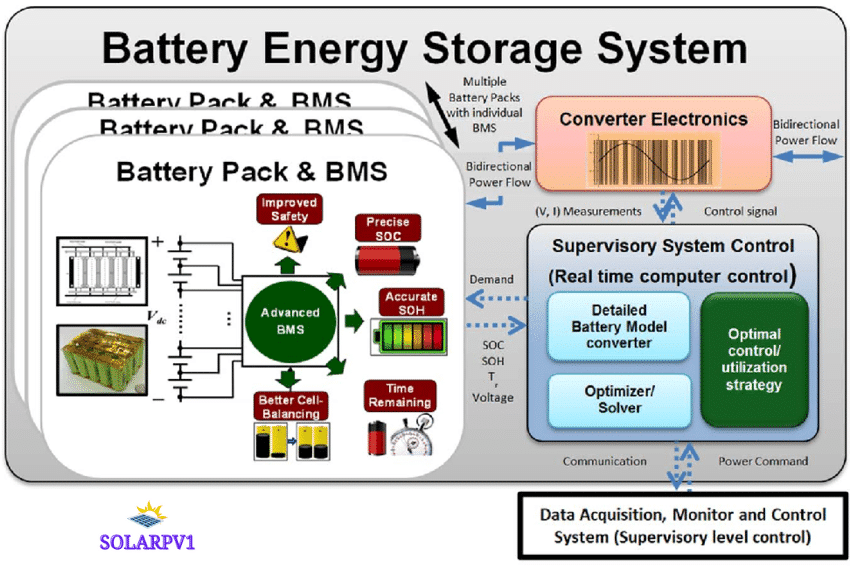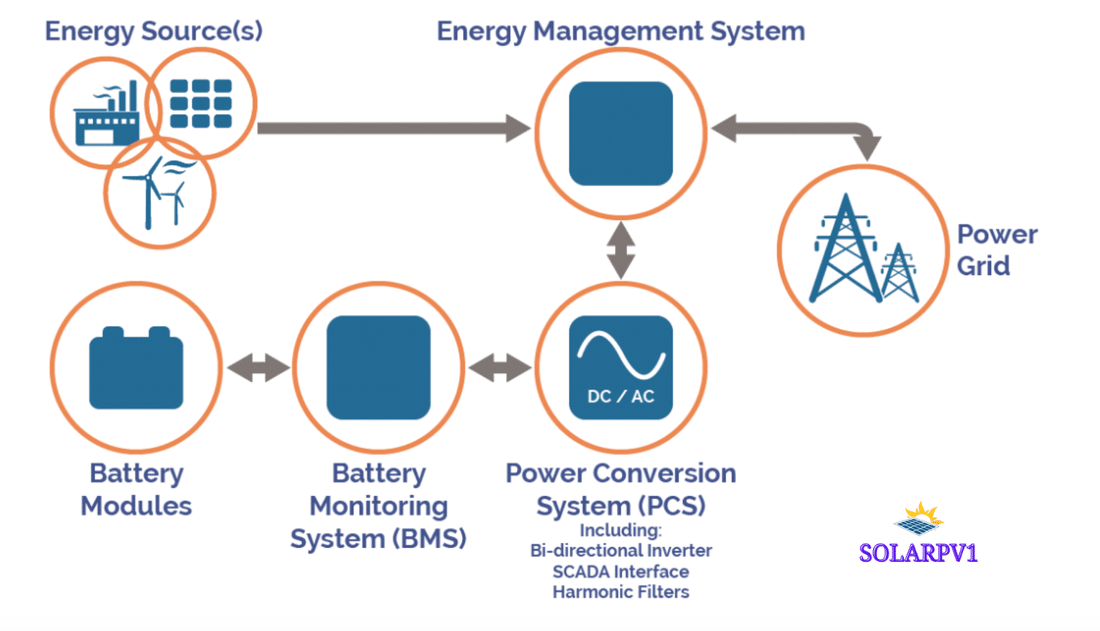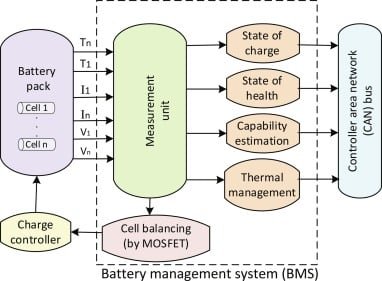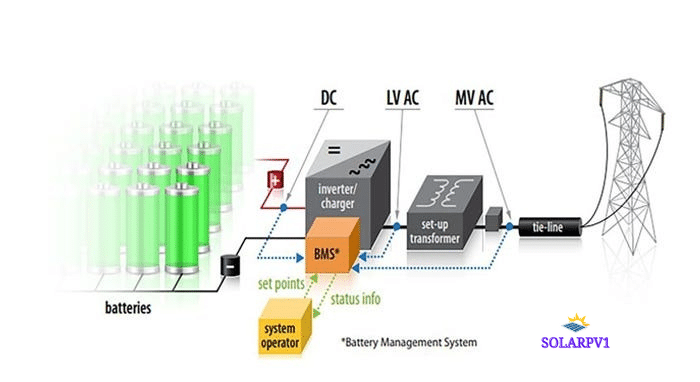Introduction to Battery Energy Storage Systems (BESS) Battery Management Systems
Battery Energy Storage Systems (BESS) represent a pivotal development in the realm of energy management, particularly in the context of integrating renewable energy sources. BESS primarily serve the function of storing energy generated during periods of low demand and discharging it during peak consumption times, acting as a vital intermediary between energy generation and consumption. This functionality is crucial for balancing supply and demand, enabling a more resilient and efficient energy grid.
The importance of BESS becomes evident as the global energy landscape shifts towards sustainable practices. With the increase in intermittent renewable energy sources, such as solar and wind, the integration of BESS is essential to enhance grid stability and reliability. By storing excess energy produced during optimal generation periods, these systems mitigate the challenges associated with fluctuations in energy supply, ensuring a consistent and uninterrupted power flow. Furthermore, BESS can participate in ancillary services to support grid operations, enhancing overall system resilience.

Different types of batteries are employed in BESS, each selected based on specific performance metrics and intended applications. Lithium-ion batteries, known for their high energy density and efficiency, are prevalent in commercial and residential applications. Lead-acid batteries, although older technology, are commonly utilized due to their established presence and cost-effectiveness. Additionally, emerging technologies like flow batteries and solid-state batteries are gaining traction for their potential in large-scale and long-duration energy storage applications. The adaptability of these various battery types underscores the versatility of BESS in accommodating diverse energy storage needs.
In summary, Battery Energy Storage Systems constitute a critical component in modern energy infrastructure, facilitating the effective use of renewable energy and enhancing grid management capabilities. Their growing significance points towards a future of sustainable energy practices that promise to deliver a balanced and reliable power supply.
What is a Battery Management System (BMS)?
A Battery Management System, commonly referred to as a BMS, is an essential component in Battery Energy Storage Systems (BESS). It functions primarily to monitor and manage the performance of battery packs, ensuring optimal operation and safety. The BMS plays a critical role in preventing overcharging, excessive discharging, and temperature extremes that can lead to battery degradation or failure. By assessing individual cell voltages and temperatures, the BMS can make informed decisions that significantly enhance battery lifecycle and efficiency.
At its core, a BMS consists of both hardware and software components. The hardware typically includes sensors, connectors, and a microcontroller, which collectively facilitate real-time data collection from the battery cells. These sensors continuously track parameters such as state of charge (SOC), state of health (SOH), and temperature, providing essential information for the system’s operation. The software aspect of a BMS involves sophisticated algorithms that interpret the data collected by hardware. This software is crucial for optimizing the charging and discharging processes, thus maximizing battery utilization.
Moreover, the comprehensive functionality of a BMS not only encompasses performance monitoring but also safety enhancements. By analyzing operational data, the BMS can implement protective measures, such as disconnecting the battery when unsafe conditions are detected. For instance, if a battery cell reaches an unsafe temperature or voltage level, the BMS can initiate a shutdown to prevent potential hazards, thereby safeguarding both the battery and the broader energy storage system.
In summary, a Battery Management System (BMS) is fundamental to the effective operation of Battery Energy Storage Systems (BESS). Through its combination of hardware sensors and intelligent software, the BMS ensures optimal battery operation, enhances safety, and extends the overall battery lifecycle.
Key Functions of a BMS in BESS
A Battery Management System (BMS) plays a crucial role in optimizing the performance and longevity of Battery Energy Storage Systems (BESS). Its key functions include state-of-charge (SOC) estimation, state-of-health (SOH) monitoring, thermal management, balancing of cells, and fault detection.
Firstly, the SOC estimation is essential for determining the remaining charge within the battery cells. This measurement allows users to understand how much energy can be utilized, ensuring efficient operation and preventing over-discharge or over-charge, which can lead to irreversible damage. Furthermore, accurate SOC estimation is necessary for the integration of renewable energy sources, as it helps in managing the energy flow effectively.
Secondly, the SOH monitoring function assesses the overall health of the batteries, identifying deteriorating performance over time. By continuously analyzing parameters such as capacity fade and internal resistance, the BMS can predict potential failures and minimize downtime. This monitoring can significantly enhance the battery lifespan and reliability, giving operators confidence in the performance of their BESS.
In addition, thermal management is a vital function of the BMS, which ensures that battery cells operate within safe temperature ranges. Batteries that are subject to extreme temperatures can experience reduced efficiency and durability. The BMS employs active and passive cooling methods to maintain an optimal thermal environment, thereby enhancing safety and performance.
Lastly, fault detection is essential for identifying abnormal conditions that may compromise the operational integrity of the BESS. The BMS continuously monitors for irregularities, such as short circuits or over-voltage, allowing for immediate corrective action. This proactive approach not only safeguards the batteries but also enhances the overall efficiency and reliability of the energy storage system.
The Role of BMS in Safety and Reliability
Battery Management Systems (BMS) play a crucial role in ensuring the safety and reliability of Battery Energy Storage Systems (BESS). These systems are increasingly being utilized across various applications, from renewable energy integration to electric vehicle charging, making the safety features of BMS all the more important. One of the primary functions of a BMS is to monitor battery conditions continually, which includes overseeing voltage levels, temperature, and state of charge. This oversight is essential for preventing hazardous situations that could arise during the operation of a battery.
Over-voltage protection is a significant feature of BMS that prevents the battery cells from exceeding their maximum voltage limits, which can lead to cell degradation or even catastrophic failure. By implementing voltage limits and disconnecting the battery when excessive voltage is detected, the BMS safeguards the integrity of the entire energy storage system. Similarly, under-voltage protection is implemented to avoid over-discharging the battery, which may result in permanent damage or reduced lifespan.
In addition to voltage protections, BMS also features short-circuit prevention mechanisms. These systems swiftly detect abnormal current levels, which could be indicative of a short circuit, and promptly disconnect the battery from the load. This action serves to protect both the battery and connected devices from extensive damage
Finally, thermal runaway prevention is another critical aspect of BMS functionality. This phenomenon occurs when excessive heat generation leads to further increases in temperature, posing a severe risk of fire or explosion. Through continuous temperature monitoring and advanced thermal management strategies, the BMS can mitigate the risks associated with thermal runaway. By implementing these safety features, a well-designed BMS ensures that Battery Energy Storage Systems operate reliably and safely, thus fostering trust in their use across various sectors.
Integration of BMS with Other System Components
Battery Management Systems (BMS) play a pivotal role in Battery Energy Storage Systems (BESS) by ensuring the safe and efficient operation of the battery pack. One of the key aspects of a BMS is its integration with other system components, such as inverters, chargers, and energy management systems (EMS). This collaboration is essential for maintaining the performance and longevity of energy storage solutions.
Inverters, which convert direct current (DC) from the battery into alternating current (AC) for use in the grid or local loads, rely heavily on accurate data provided by the BMS. The BMS monitors critical parameters, including voltage, current, and temperature, allowing the inverter to operate within safe thresholds. The communication protocol between the BMS and inverter, often employing standards like Modbus or CAN bus, ensures real-time data exchange, enabling effective control and optimization of energy flow.
Chargers also benefit from a well-integrated BMS. During the charging process, the BMS informs the charger about the battery’s state of charge (SOC) and health status, which facilitates an appropriate charging strategy. This interaction helps to optimize the charging rate and prevents overcharging, thus extending the lifespan of the battery. The use of communication protocols such as CAN or RS-485 allows these systems to work harmoniously, maximizing overall efficiency.
Another crucial component is the EMS, which manages energy consumption and generation in the BESS. The BMS provides valuable information about battery status and availability, allowing the EMS to make informed decisions on when to store energy or release it to the grid. The integration of BMS with the EMS not only enhances the reliability of the energy storage system but also contributes to energy management strategies that support grid stability.
Ultimately, the seamless interaction between BMS and other system components is vital for the optimal performance of Battery Energy Storage Systems. By ensuring that all elements communicate effectively, users can achieve enhanced safety, efficiency, and reliability in energy storage applications.
Technological Advancements in BMS for BESS
The evolution of Battery Management Systems (BMS) is crucial for the advancement of Battery Energy Storage Systems (BESS). Recent developments reflect a growing integration of smart technologies, particularly artificial intelligence (AI) and machine learning (ML), which significantly enhance the operational efficiency and reliability of BESS. These smart BMS solutions offer real-time monitoring and adaptive management capabilities, optimizing battery performance and extending lifespan through advanced algorithms.
One notable trend in BMS technology is the implementation of predictive analytics. By leveraging historical data and trend analysis, BMS can forecast battery behavior and performance under various circumstances. This allows operators to proactively address potential issues before they escalate, thus improving reliability and minimizing downtime. Additionally, these predictive models can adjust charging and discharging cycles based on expected usage patterns, ultimately enhancing overall energy efficiency.
Furthermore, improved data analytics capabilities are becoming instrumental in the management of BESS. The ability to collect and analyze vast amounts of data from battery cells plays a significant role in fault detection, performance benchmarking, and optimization strategies. Advanced analytics can also facilitate condition monitoring, allowing for the identification of anomalies that could signal a decline in performance, therefore prompting early intervention.
Another significant advancement is the enhancement of communication features within modern BMS. With the rise of the Internet of Things (IoT), interconnectivity among different system components has improved. This ensures seamless data exchange between BESS and other grid components, enabling better integration and coordination within larger energy systems. Such enhancements contribute to the resilience of energy storage systems, allowing them to adapt more effectively to changing energy demands.
These technological advancements collectively represent a transformative shift in the functionalities of BMS for BESS, setting the foundation for a more secure and efficient energy future.
Challenges and Limitations of BMS
The implementation of Battery Management Systems (BMS) within Battery Energy Storage Systems (BESS) is critical for ensuring optimal performance and longevity of batteries. However, several challenges and limitations plague the effective management and operation of BMS across various applications. One primary issue is communication difficulties, which can arise due to the increased complexity of modern BESS setups. When managing multiple battery packs, effective communication between the battery cells and the BMS can be hindered by physical distances, highly varied electrical characteristics, or environmental interferences, leading to inefficient monitoring and control.
Another significant challenge lies in the complexity of management algorithms. These algorithms are central to accurately gauging battery health, state of charge, and state of health. However, the sophistication required for these algorithms can be overwhelming, especially as battery technology advances. The need for real-time data processing can also strain computational resources and lead to delays, compromising the overall system performance.
Cost implications represent a further limitation within BMS technologies. High-quality components, sophisticated software, and rigorous testing protocols can drive up costs, potentially making these systems financially unviable for some projects. This is particularly pertinent in residential and commercial settings, where budget constraints are a serious consideration. In addition, the integration of new technologies, although promising, often comes with substantial upfront investments, which can deter widespread adoption.
To mitigate these challenges, BMS developers can focus on enhancing communication protocols, simplifying management algorithms, and optimizing cost-effective components. Collaborations between manufacturers, researchers, and service providers can also stimulate innovation and lead to the design of more robust and user-friendly systems. By addressing these limitations, the functionality and practicality of BMS in BESS applications can be significantly enhanced.
Future Trends in BMS for BESS
The future of Battery Management Systems (BMS) in Battery Energy Storage Systems (BESS) is poised for significant advancements driven by evolving technology landscapes and increasing market demands. One of the prominent trends is the integration of artificial intelligence (AI) and machine learning into BMS to enhance predictive maintenance and operational efficiency. AI algorithms can analyze data patterns, allowing systems to forecast potential failures or inefficiencies in real-time, thus improving reliability and reducing downtime. This innovation will also empower users to optimize their energy usage and extend the lifespan of their batteries.
Another key development is the emphasis on enhanced safety protocols within BMS frameworks. With the proliferation of renewable energy sources and the corresponding increase in battery use, regulatory requirements are expected to tighten. Consequently, BMS will increasingly incorporate advanced thermal management systems, fire detection mechanisms, and fail-safe controls to ensure maximum safety during operation. Such enhancements are vital to meet stringent safety standards and public concerns regarding battery operation.
Furthermore, as the demand for electric vehicles and grid-scale storage systems rises, the scalability of BESS will become a focal point. Future BMS designs are likely to feature modular architectures that facilitate easier upgrades and integration into existing systems. This modularity will provide flexibility for users who require varying storage capacities, enabling them to expand their systems without complete overhauls.
Lastly, the growing trend towards sustainability will influence the development of BMS technologies. Manufacturers are expected to prioritize eco-friendly materials and processes in the production of energy systems. Recyclability and the carbon footprint of BESS will enter the regulatory spotlight, prompting BMS innovations that align with global sustainability goals. Overall, these future trends indicate a transformative era for BMS in the realm of energy storage, ultimately enhancing their efficiency, safety, and performance.


